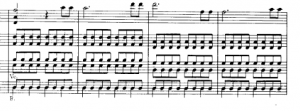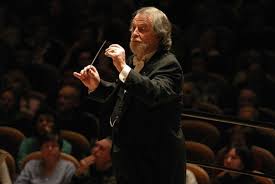George Cleve
Facebook brought me the news this morning that George Cleve died yesterday. I knew he’d had health issues for a long time, but this hit me like a brick anyway.
I first worked for George in 1974 upon my return from studying at a rather strange school in Switzerland known as the Institute for Advanced Musical Studies (Institute de Haute Etudes Musicale, or IHEM). The San José Symphony’s assistant principal violist at the time, a young women named Lorraine Hunt (later famous as the great mezzo Lorraine Hunt Lieberson) needed to back out of a series of MPTF school concerts that the orchestra was presenting, and I was hired to replace her for the run of 20 or so, all of which George conducted.
That spring, two members of the San José Symphony, principal horn Wendell Rider and principal oboe Bob Hubbard, approached George about starting a Mozart festival. The first season of the Midsummer Mozart Festival was that summer and I got “hired” for that as well (“hired” because we would split the gate after expenses, which amounted to around $6.00 each, as I recall). But it was a wonderful experience musically, and the three of them were able to put the Festival on a more solid (and better-paying) basis for the following years. I stayed with the Festival for 10 seasons, and, although it eventually shrunk from its 3-week length years after I left, it has run continuously since that first season in 1974, becoming a Bay Area summer tradition. And, after I left the Bay Area, I got to work for George several times when he guest-conducted the orchestras in which I was working. So I got to know him pretty well as a conductor.
Oddly enough, I got to know him on a personal level as well; his wife, flutist Maria Tamburrino, was friends with my mother before George and Maria met (my Mom was a flute teacher who would send her students on to study with Maria when they advanced beyond beginner level), and later my father, who was a big fan of George’s Mahler in particular, also became friends with George and Maria. In fact the last time I saw George was at my Dad’s memorial service (at which Maria played); we had a lovely chat about our mutual admiration for Bruckner and Barbirolli, as I recall.
George was both an extraordinary conductor and an extraordinary musician. As a conductor, he was unsurpassed in being able to get an orchestra to play precisely together simply by what he was doing physically. He was also the best accompanist I’ve ever seen. I vividly remember a performance George conducted of the Schumann cello concerto with Lynn Harrell and the Saint Paul Chamber Orchestra in the early 1980s. Harrell’s performance was, of course, wonderful – but it was extremely free (perhaps because, as someone who knew George, he trusted that George would be able to follow him). The hall we played in at the time was less than ideal in terms hearing from side to side onstage, and the firsts were even farther away from the violas than usual, due to the riser for the solo cellist being in the way. I felt completely at sea in terms of hearing anything I could follow, and the whole thing could easily have been a mess. But the tape of the live performance was just about flawless. Very, very few conductors could have done nearly as well.
He was also remarkably efficient technically. George was a protege of Pierre Monteux, and it showed. (George, like Monteux, was also a violist.) Like Monteux, his basic technique was very economical; very little movement of the torso or head and almost no stepping around on the podium. It was all done with the arms and hands, mostly in front of the body. (go to 1:15 of this video to see Monteux being economical). So, when George did something that wasn’t economical, it really caught the orchestra’s attention. Those extra gestures, when they came, were remarkably expressive. I always found him a fun conductor to watch, as well as an extremely easy one to follow.
In 1978, George was nearly killed in a fire, caused by a defective furnace, that burnt down his house in Berkeley and killed the person who was visiting with him. About three months later (and just a few weeks after he’d been released from the burn unit), he made his first post-fire public appearance at the first rehearsal of the first program of that year’s Midsummer Mozart Festival, on which he was to conduct one piece, the Symphony No. 34 in C (nowadays we’d call that “work hardening”). I remember vividly that he could barely move; he was wrapped up in pressure bandages and the movement of his hands was confined to a box about 1′ by 1′ by 1′. It didn’t matter; that was enough for George to be able to convey all that was necessary. I’ve never seen a conductor do so much with such little apparent effort. It was a piece that George did really well even in normal circumstances; that particular performance, though, was very special.
But what really made George special was what he brought musically. Someone who worked a lot with George put it well on Facebook (which has many tributes to him from Bay Area musicians):
Let me just say that there are countless things in the symphonic and opera literature that are defined for me by having done them with George… No other interpretation ever lives up to his. I’m playing along and there’s another track in my head of the way it *should* be, the way George did it. It’s his legacy: that a whole generation of us were shaped and trained by him.
I had the same experience. George had insights that were both so original and so “right” that they would stick permanently in my mind. What I found fascinating, though, is just how many of those insights were already in the score; George just found them – I suspect by obsessing on the music until he saw beneath the layers of past practice. They were often quite simple: noticing that a conventional bowing created a bad phrasing (George asked the violins to start this tune from K. 456 on a down bow when he noticed that the last three notes would fade out when started up; it fixed the problem),
 or noticing that Mozart asked for dotted half notes rather than half notes plus quarter rests in this passage from The Marriage of Figaro
or noticing that Mozart asked for dotted half notes rather than half notes plus quarter rests in this passage from The Marriage of Figaro
and asking the firsts to really sustain the long notes, or that the phrasing of the music should reflect the words in the Hallelujah chorus, so that “Christ” is the climax of the phrase, or that the violas had something really important at this moment in the Jupiter symphony. 
(I remember the rehearsal when he asked for the Marriage of Figaro thing; he said he’s figured it out it on the drive to rehearsal, and I’m pretty sure he was the one driving. That’s what I mean by “obsessing” – I suspect George spent a lot of time thinking about music, and not just figuring out the score.)
George’s approach did change over the years. I did the Prague symphony three times with him from 1974 through sometime in the early 1980s, and heard the recording of a performance from around 2000. They were all great, but the insights that were brought out vigorously in 1974 were all much more subtly done in 2000. The effect was that of going from a very bold and energetic interpretation to simply hearing what Mozart wrote. George, as the interlocutor, was still there, but became essentially invisible; semplice interpretation at its best.
I have come to realize, with experience, that great performances leave the listener hearing the music and not the interpretation. Truly great performances create the impression that the listener has never really heard the piece before. George could create those more often than anyone else I’ve known.
Of course there were reasons why a conductor of George’s caliber didn’t have the kind of career that he should have. George could be “difficult.” He was, for one thing, very moody, and a rehearsal when he was in a bad mood was not fun – not because he was abusive, although he had moments along those lines, but because he would seem to quit trying – very discouraging for the orchestra, and particularly those of us who liked him. That would, on occasion, happen in concerts as well when something went badly, especially if he blamed himself.
My impression was that he learned how not do to that over time; I certainly never saw any of that on those occasions he guest-conducted my orchestras. But, even when behaving impeccably, there was something about George that annoyed some musicians. I could never figure it out. One older musician I respected suggested that George tried – unconsciously at least – to reverse the normal sado-masochistic relationship between conductor and orchestra, which bothered those musicians who were used to having a conductor who clearly wanted to dominate those in front of him. While that was a witty explanation, I think it was more that George was neither ebullient nor clearly happier to be in front of the orchestra than anywhere else. Actively demonstrating a positive attitude is a trait common to most conductors who orchestras immediately like (and one that conductors should display), but such ebullience was not in his repertoire – that’s the closest I ever came to an explanation. There were many musicians who could see past that to what George had to offer, especially those who worked with him on a regular basis, but a surprising number (surprising to me, at least) couldn’t.
Having said that, it’s wonderful to see the outpouring of affection for George on Facebook; those of us who were fans felt very strongly about him. It’s hard to imagine not ever getting to work with him again.
Fortunately, there is a record of at least some of his work; a few recordings and some Youtube videos. The one I like the best is a performance of Mozart’s Symphony No. 39 with (I believe) the Swedish Radio Orchestra. It has all of George’s hallmarks; crisp and rhythmically incisive playing, lots of energy, some really good ideas, and very expressive conducting without excess motion. I think he was enjoying himself – although not much enjoying the applause afterwards, which was typical for him. He was always in it for the right reasons.


Robert, this is a wonderful description of George Cleve’s conducting. I had the honor & privilege of playing the Midsummer Mozart festival for 4 seasons, the most recent in 2012.
Yes, he could be difficult at times, but it was always because he was frustrated that the music was not being served adequately, for whatever reason. It was never an ego thing with George. He just wanted it to be RIGHT. We all understood this and carried on, because he WAS right, and we reaped so many wonderful music rewards by working with this extraordinary conductor.
Thank you for your thoughtful contribution to George’s memory!
Thanks so much for a beautiful and balanced piece about George Cleve. Even now I can’t believe he’s gone. He made music come alive for me, at many stages of my career. As your tribute suggests, he both made me cry, and he made me cry.